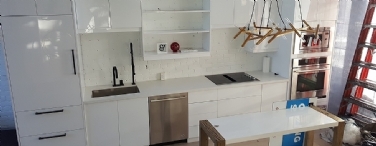
Radiant in-floor heating is becoming a favourite of both new home builders and renovators across the country. This is because homeowners are beginning to appreciate the benefits of heating the floor rather than depending on traditional forms of heating like baseboard heaters and heat vents.
Furnaces are Hot and Cold
A furnace-style heating system depends on thermostats to regulate the core temperature. When the area around the thermostat drops below the set temperature a gas or oil furnace will ignite. Then it takes a few moments for the air in the plenum above the furnace to heat up before the blower is activated. The initial air that is forced from the vents into the home is cool until the pipes heat up. So it takes five minutes or so before the house begins to receive heat.
Once the room attains the prescribed temperature the furnace kicks off and the blower keeps forcing out air for a few more minutes.
Then, depending on the insulation and the size of the windows, the room begins to cool and the cycle begins again.
Hot water heating systems that run water through radiators and are a more even form of hear, as are electric baseboard heaters, but they are geared to heating the exterior walls and their radiation takes a while to make the room an even temperature.
The Radiant In-Floor Heating Concept
Radiant in-floor, or underfloor, heat uses the whole floor as a heater. Heat is generated within the floor by either plastic PEX tubes filled with a heated liquid or from strings of electrical wiring. The floor is a thin, concrete pad or capable of thermal storage. On top of the pad are ceramic tile or natural stone that will heat evenly and continue to give off heat after the source has been deactivated.
This form of heating is far from a new invention. Ancient Roman bath houses had hot water circulation under the stone and clay floors. In Iceland, where geothermal springs abound, the houses of the city of Reykjavik are heated from hot water piped from a main thermal source.
Hot Water Infloor Heating
Houses that use hot water in-floor heating are some of the most efficient homes in the country. Some systems use water heated in an electric or gas hot water tank which includes hot water for showering and washing. Other heating units use a completely separate circulatory containing a coolant like Glycol, which is like automobile anti-freeze, through the PEX tubes that have been built into the slab floor. In both systems the heat process can be separate from the main hot water tank.
Radiant infloor heating can also be used under a wooden substrate and is often employed alongside the joists of a floor. The plastic PEX tubing is attached under the wooden substrate along with radiant foil that will reflect heat up through the subfloor and into the flooring.
The best time to install a hot water, radiant infloor heating system is during the construction of a home. It works really well in the basement too where the whole floor can be heated to provide a sustaining heat for whole basement and into the upper floors. In all cases the PEX tubes are strung in racks on the concrete that keep them separated. On a wooden substrate a radiant foil is usually put down first before the racks are embedded into the floor. Then they are covered with a Portland cement-based mortar that is smoothed into a pad. Once finished and smoothed the surface can be covered with ceramic tile, stone and even engineered-hardwood flooring.
Most hydronic operations are "closed-loop system". The tubing is divided into zones, each with its own thermostat and circulatory system. A thermostat operates a zone valve which can hot water into the tubes under the floor of that certain area. Once the heat is drawn from the tubing and into the floor the cool water flows back to the heating source.
Electric In-Floor Heating
The floor can also be heated with electric wiring. For large areas a metal holder is attached to the substrate in and the wire is wrapped around the pegs in equi-distant coils. Another method that is gaining popularity is a specialized mat that holds the wiring much like a mosaic tile is suspended on a screen-like mat. The first method requires manually stringing the wire - and is used for large areas - and the mat version is rolled out onto smaller floors where heat is needed like bathrooms or in kitchens. Both are coated with mortar.
Electric in-floor heating can be either 110 volt or 220 volt making either easy to connect to the present system house systems. This means that if the primary heat for a room is an electric baseboard the present 220 volt wiring can be used. The new floor system is hooked into the present circuit and the old thermostat is then changed for a new one that can be programmed for the busiest times of the day.
Except for the electrical hook-up, both systems can be a do-it-yourself job. However, for the best result, hire a flooring contractor who can make sure the infloor heating works perfectly. Our Contractor Directory has a list of some great professionals or simply post your project online.
Posted by: TrustedPros





